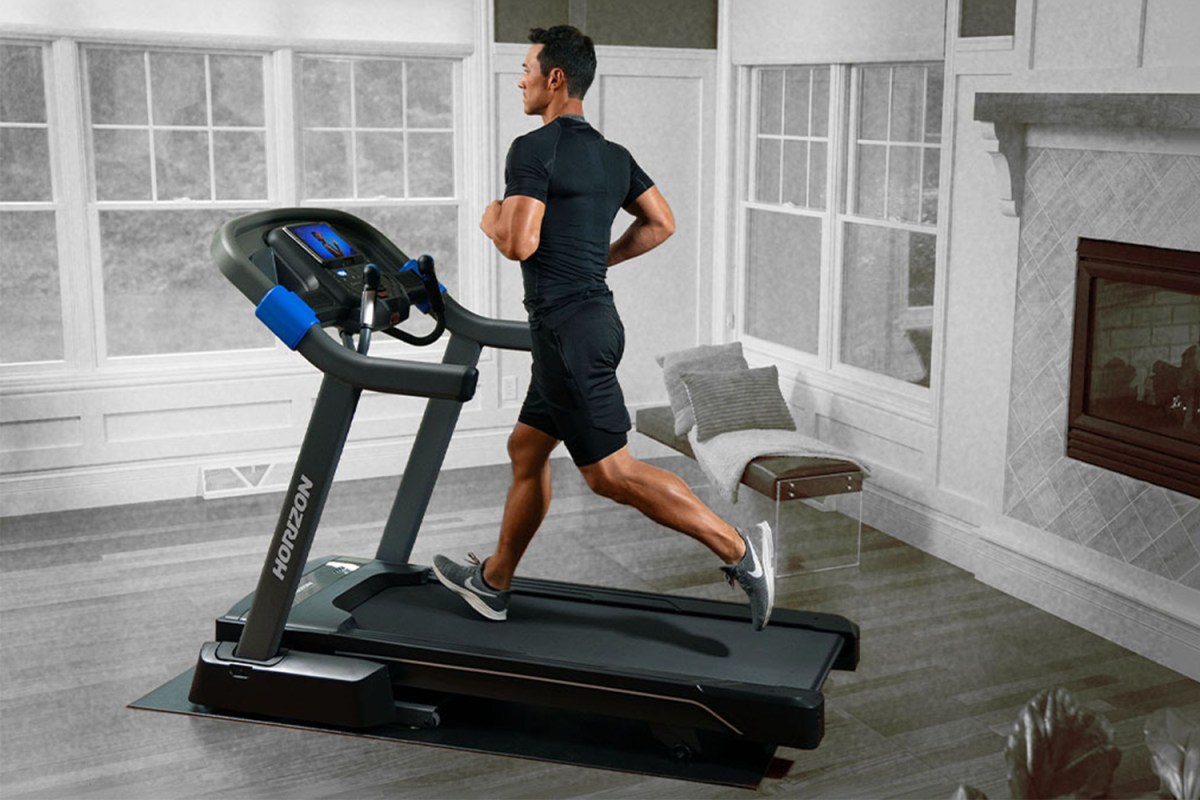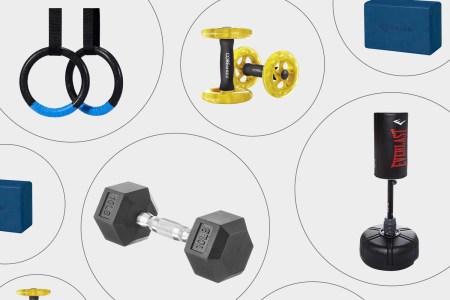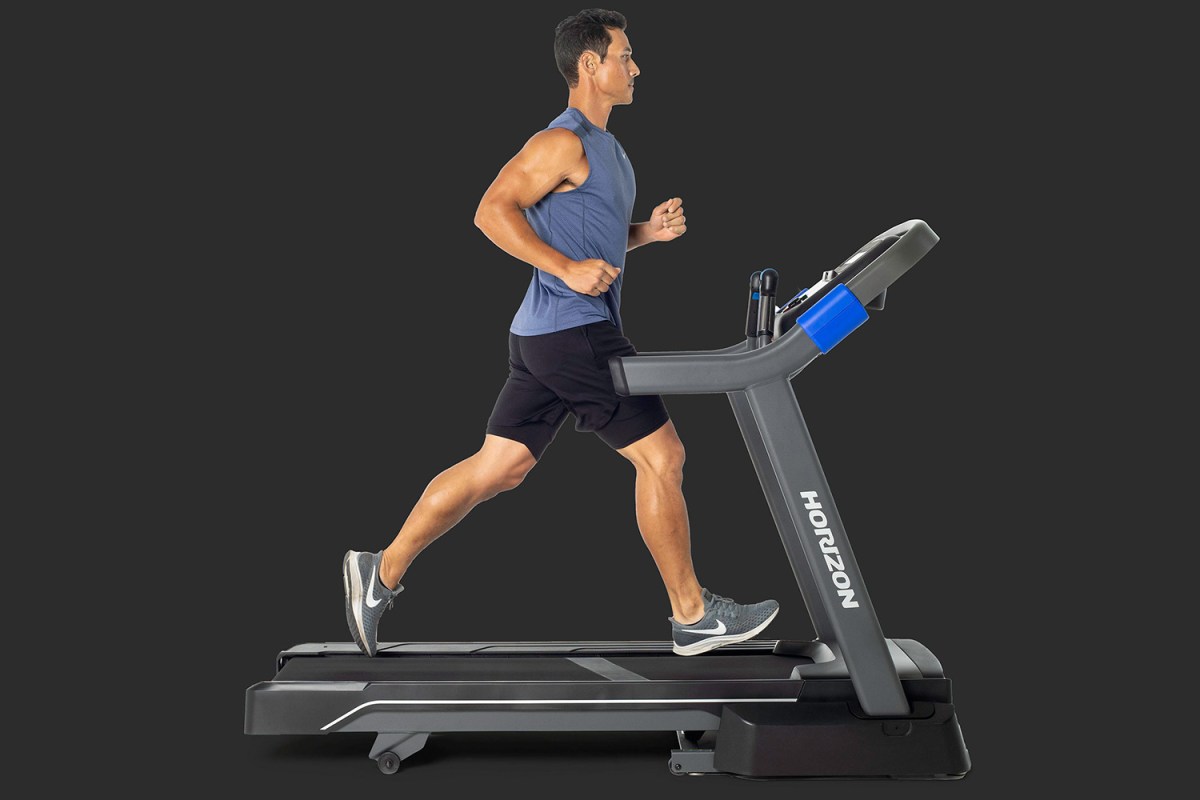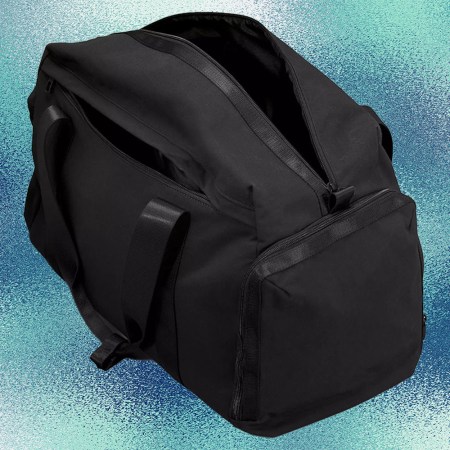Nota bene: All products in this article are independently selected and vetted by InsideHook editors. If you buy something, we may earn an affiliate commission.
A perky Peloton instructor, looking into my eyes through the screen in front of me, explains how to work my treadmill before starting my morning run. On the right I should see a knob that adjusts the speed by rolling it back and forth. (Check.) On the left I should see an identical knob for changing the incline. (Check.) He says there are two other ways to stop the machine: a red button and a safety key that attaches to my clothing. (Double check.)
There’s just one thing wrong with this picture: I’m not standing on a Peloton Tread, the bike-first brand’s running unit, but the 7.0 AT Treadmill from Horizon Fitness.
The 7.0 AT is an economical folding treadmill from a brand you may not be familiar with, but Horizon is trying to change that by positioning their equipment as affordable and platform-agnostic versions of high-tech models from bigger brands. Their design replicates some of the innovative features found on the Peloton Tread (rolling dials instead of buttons or toggles for changing speed), and they’ve built it so you can take classes from competitors on their units (Peloton, Zwift, Studio, etc.). Unlike other modern fitness machines, you don’t need to pay for a monthly content subscription from Horizon Fitness after buying the treadmill itself. You can use pretty much any fitness app you want, or simply use the treadmill without any app at all.
On the surface, this machine from Horizon seems like a no-brainer for those looking to add a treadmill to their home gym (or, like me, open space in their basement), especially in the obvious comparison they’ve engineered. The Peloton Tread currently starts at $2,995, while the Horizon 7.0 AT can be had for just $999. [Update: This review is of the 2022 model. The newer edition is mostly the same, including the price, but it features a redesigned interface and device holder on top so any phone or tablet you use will be at eye level.]
After spending a month testing this Horizon model, it became clear the comparison wasn’t so simple. Here’s what prospective buyers need to know.
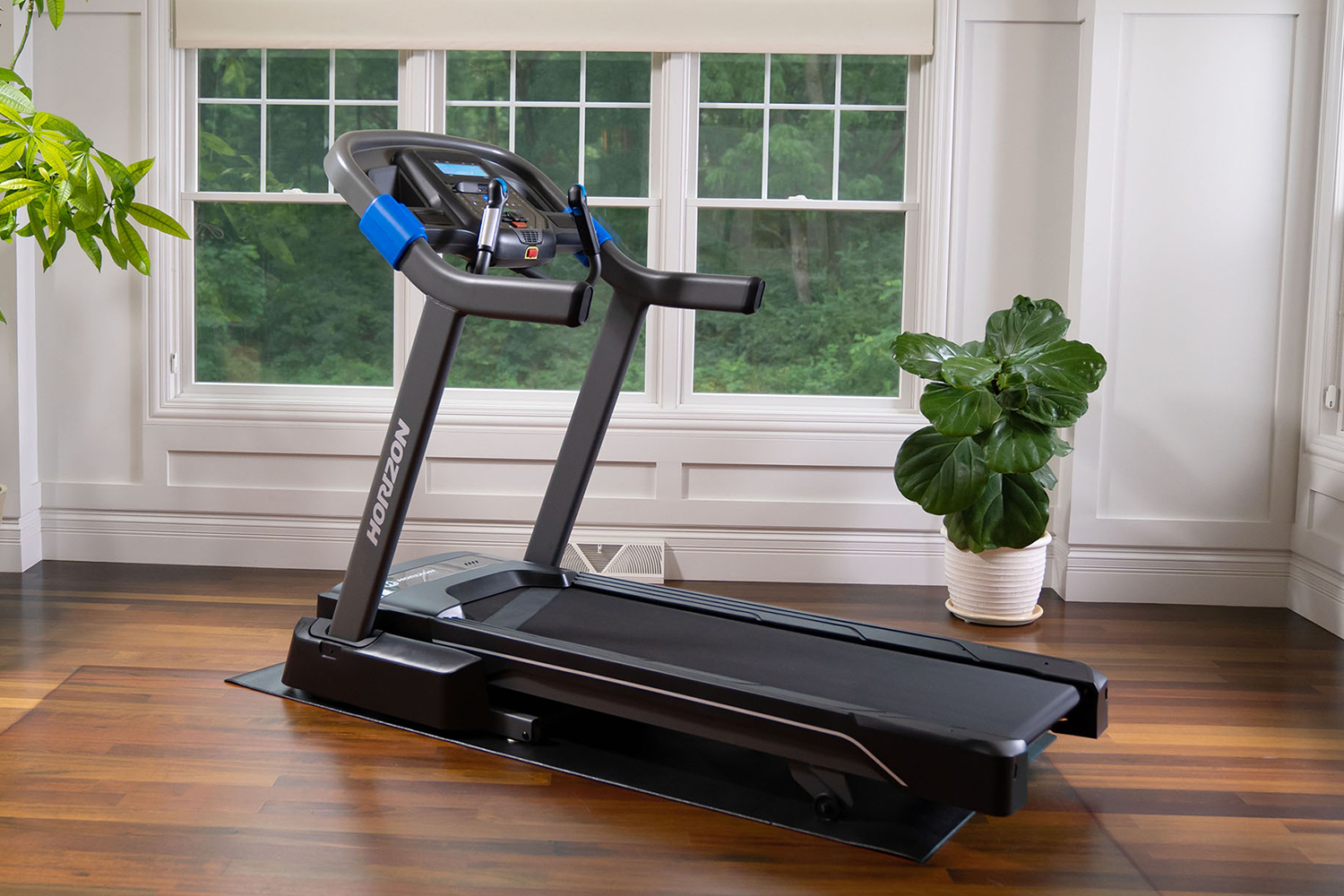
The Basics of the Horizon Fitness 7.0 AT
The 7.0 AT is the least expensive treadmill in Horizon’s Studio Series line, where the models are designed to be used with streaming classes. The brand also sells the more pared down Go Series, which starts even cheaper, at $649 for the T101.
The main difference is that the Studio Series machines all feature an extra set of arms that bend out in front of the treadmill interface with blue wheels on the end. These are the QuickDial controls, which were introduced on the model in 2020, two years after Peloton launched their treadmill with rolling knobs on the side to more easily bump the speed or incline up or down while you’re jogging, running or sprinting. Anyone who’s spent significant time running on a machine from any other brand knows the awkwardness of frantically tapping the minus button on the screen while galloping with the running belt screaming underneath you. This rolling feature hopes to make your ups and downs seamless.
10 Trainers on the One Piece of Fitness Equipment They Can’t Live Without
From core wheels to gymnastic rings to punching bags, here’s how to stock your home gym economicallyYou’re also getting a lot of treadmill for the price. I’m speaking literally here: the running area is a generous 60 inches long and 20 inches wide. That’s an inch longer than the Peloton Tread and just two inches narrower than the NordicTrack Commercial 2450, two of Consumer Reports’ highest-rated non-folding treadmills; it’s also just two inches skinnier than its more expensive Studio Series siblings (the 7.4 AT and the 7.8 AT), and the Sole F80, also a top-rated folding treadmill at CR. With that generous base, the 7.0 AT also allows a maximum user weight of 325 pounds.
You are not, however, getting a lot of tech. The interface on the 7.0 AT is rather simple, with no video screen, but it still includes all the buttons and information you’ll need to use the treadmill by itself, as well as nice additions like quick controls (for jumping up to a 15% incline, the maximum, or 12 mph speed, also that max) and a blue and white monitor that displays a fun track for measuring distance, along with other stats like pace.
So where’s the video screen for showing the streaming classes Horizon keeps talking about? You need to provide that yourself. The company recommends pulling up your favorite fitness app on your smartphone or tablet, then placing it on a ledge on the machine’s interface, so it acts as a bring-your-own screen on the treadmill itself. You can also connect your device to the treadmill’s Bluetooth speakers, so when your class is playing it feels as if it’s a part of the Horizon experience (rather than playing through your device speakers). Horizon has a page that recommends the fitness apps that work best with their machines, a few of which I tested during my time with the equipment.
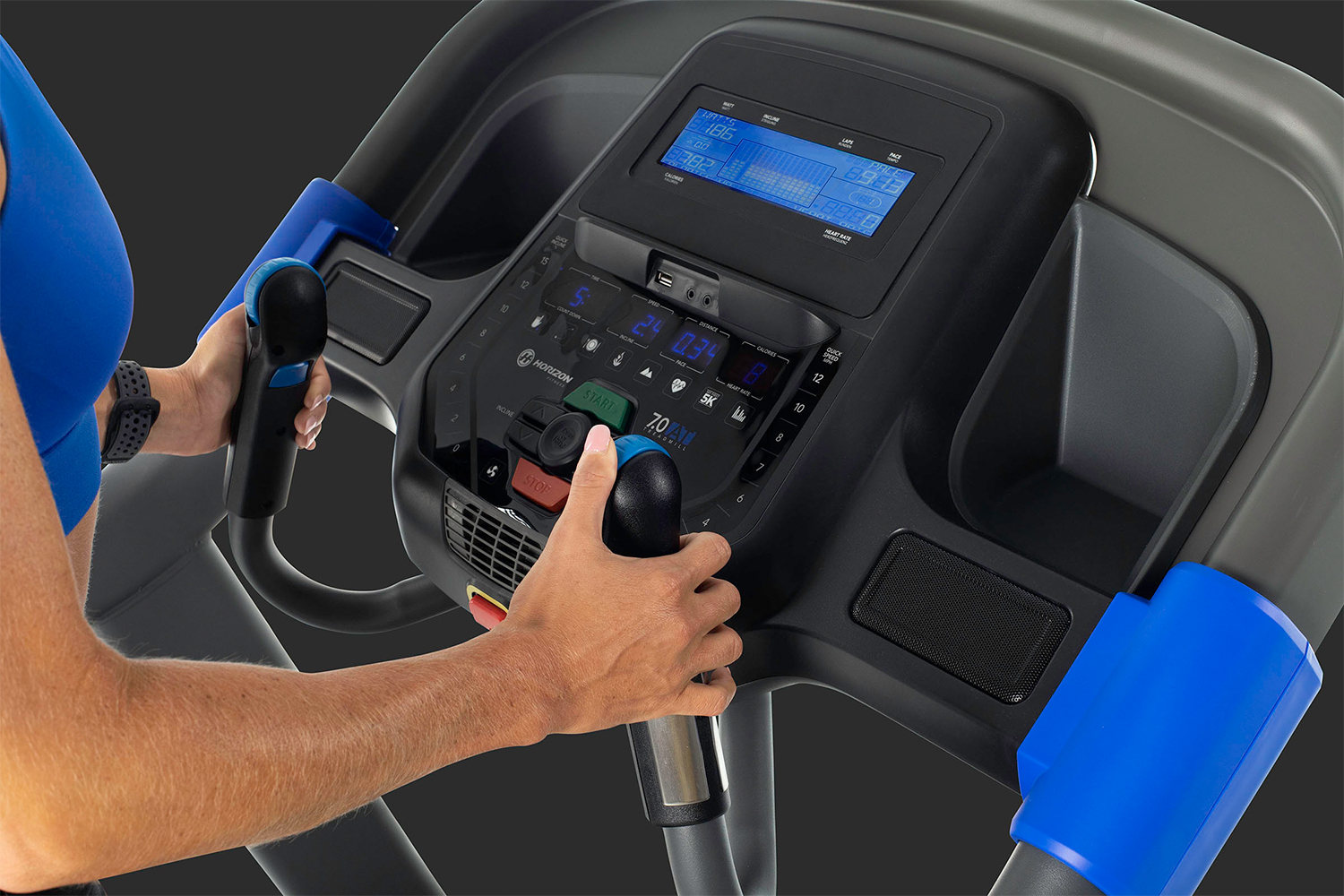
Pros and Cons, and How It Compares to Other Treadmills
After running on the 7.0 AT for four weeks, the value was impossible to deny. For under $1,000, this is a sturdy and powerful piece of home fitness equipment with plenty of features others in the price range don’t possess. It’s certainly not as solidly built as more expensive machines (especially non-folding models), and it may not go to the same extremes in speed or incline (or decline, for that matter), but as someone who is 5’11” and 200 pounds, I had no hesitation sprinting full out when my instructor in my iPhone told me to. The running surface also felt very forgiving, thanks to the brand’s 3-Zone Variable Response Cushioning.
There is however the price catch. With any heavy and complex piece of gym equipment, the stated price tag usually isn’t the full picture. For the Horizon 7.0 AT, you’ll need to spend $129 to ship the treadmill to the “threshold” of your home, which is what the company offered me for my tester. But you’ll want to buy a more expensive shipping option, because moving a humongous, unwieldy, 303-pound box (that’s the shipping weight) through small doors and up and down stairs is a huge headache that will frustrate you to no end. Trust me on that one. There’s also In-Room Delivery available for $219, but you’ll want to buy the White Glove Delivery (which includes full assembly trash removal and free returns) for $349.
So you’re really looking at a $1,230 base price (with basic delivery and sales tax), or $1,470 with my recommended delivery option. The good news here is that with the top-tier delivery you’ll have peace of mind knowing the company set up the treadmill correctly, and by buying into Horizon you’ll have peace of mind knowing your credit card statement won’t have yet another monthly subscription added to it (unless you want one). If you’re already annoyed with the number of streaming, music and other entertainment charges hitting you on a monthly basis, chances are you won’t want to be tied to a specific fitness content subscription, too. The idea behind Horizon’s Studio Series treadmills is that you will use some sort of running class app, but the machine also works just as well on its own. The 7.0 AT interface includes presets for a 5K program and hill climbs, as well as focusing on areas like calorie and fat burning, distance, and heart rate, and of course you can always manually control time, speed and incline.
In my testing, I tried classes from Peloton and Zwift, as well as running on my own. I streamed these classes on my smartphone since I don’t own a tablet. In terms of the integration with Horizon’s equipment, it was seamless. After pairing my phone via Bluetooth, every time I turned on the treadmill it auto-paired, so I could hop on in the morning even in my normally groggy state without having to futz around connecting various devices, start a class in my app of choice, and the sound came out loud and clear through the 7.0 AT’s speakers (you could always use headphones instead, too).
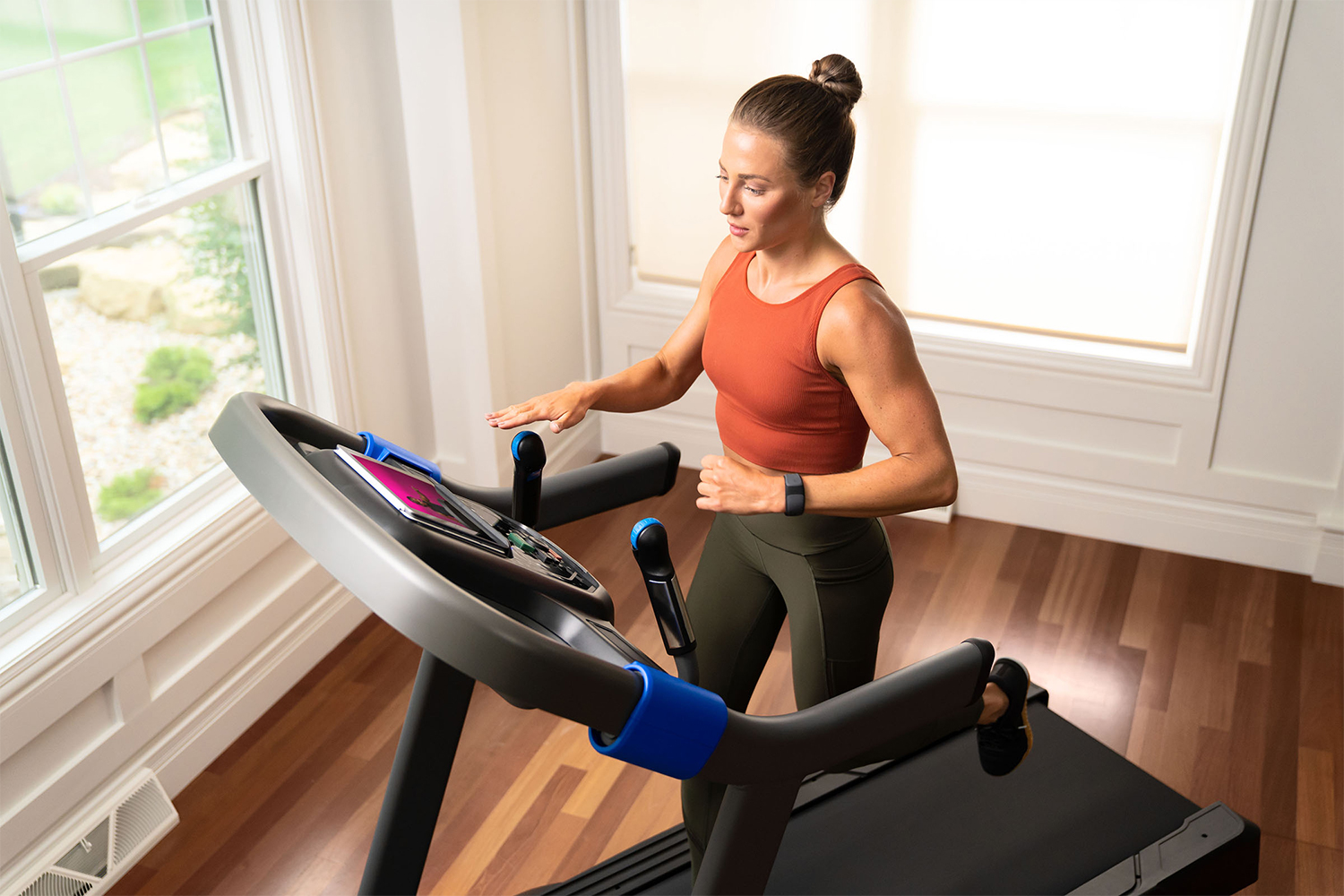
But there’s also a reason Horizon’s own photography of the treadmill shows runners with tablets and not smartphones: the experience is best with a larger screen. I kept having to crane my neck down to look at my tiny smartphone propped up on the integrated ledge of the treadmill, and unlike a tablet it didn’t cover the monitor in the interface, so it felt more like I was cobbling together a DIY home experience rather than using a dedicated, premium product that makes it worth staying home rather than going to a gym. If you have a tablet, your experience with this treadmill will be infinitely better. [Update: The improved 7.0 AT model has a device stand higher on the machine, so you can now look straight ahead at your screen.]
So was Horizon able to replicate the experience of Peloton’s ingenious design in its own machine? Yes and no. The brand’s rolling QuickDial controls were slightly easier to use than your standard treadmill’s interface of tapping a button or screen to increase or decrease speed. However, I’m a person who likes to run close to the front of the treadmill, so I found myself bumping into the QuickDial arms, which are fixed directly in front of you and extend into your running space, rather than being positioned plenty wide on the right and left arms as they are on Peloton’s Tread. The dials are fairly sensitive, so bumping into them did mess with my settings. But they’re not so sensitive that you can actually spin the wheel to rapidly increase or decrease speed.
I tested this: When sprinting during a Peloton class, I whipped the QuickDial wheel backwards to see if it would slow me to a walk; instead, nothing happened at all. Horizon seems to have engineered the wheels so you can only change your settings by slowly clicking them up or down, which both makes complete sense for safety but also makes them similar to the old method of tapping buttons up or down.
Also, in setting up the treadmill myself, the instructions manual from Horizon told me to download the brand’s own app called AFG Pro Fitness. I did, because they told me to in the guide, and because the app promised to do things like control the treadmill and store my workout history under my own profile (something I’m certainly interested in). The app turned out to be glitchy and unusable. When I reached out to Horizon, they said that they will be debuting a new app later this year. [Update: The new app, called AtZone, is now available.]
The Verdict: Who Should Buy the 7.0 AT Treadmill?
If you have a budget under $1,500, are looking for a treadmill that isn’t tied to a content subscription, and want a reliable machine whose tech is less likely to become outdated, the Horizon Fitness 7.0 AT is an affordable, robust and nifty option. If you want an all-in-one, plug-and-play piece of equipment with the latest and greatest tech in the fitness space, you may want to look elsewhere (though “latest and greatest” can often become obsolete quickly, as we saw when Lululemon decided to shut down Mirror).
We've put in the work researching, reviewing and rounding up all the shirts, jackets, shoes and accessories you'll need this season, whether it's for yourself or for gifting purposes. Sign up here for weekly style inspo direct to your inbox.
